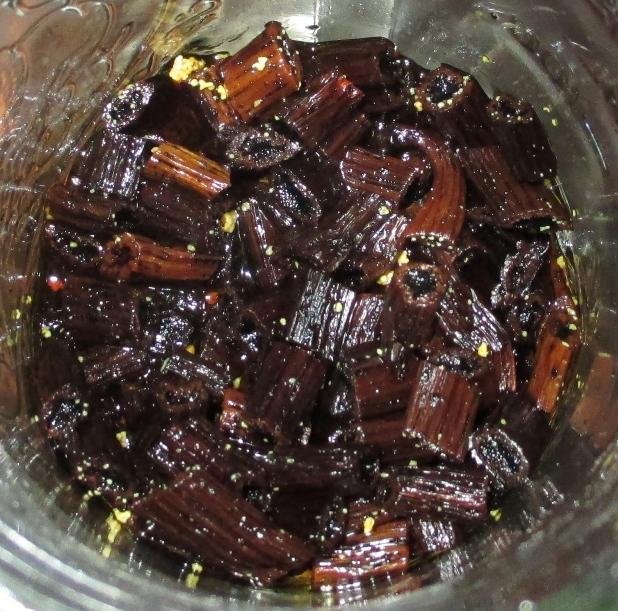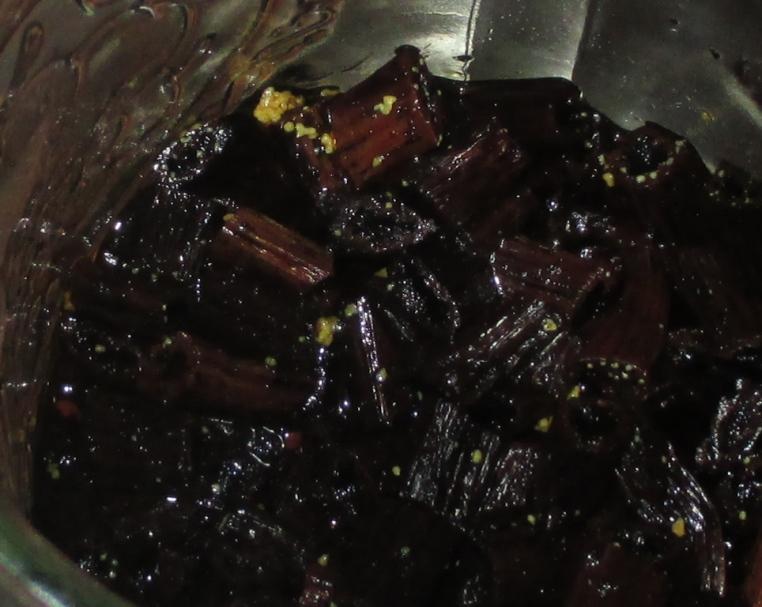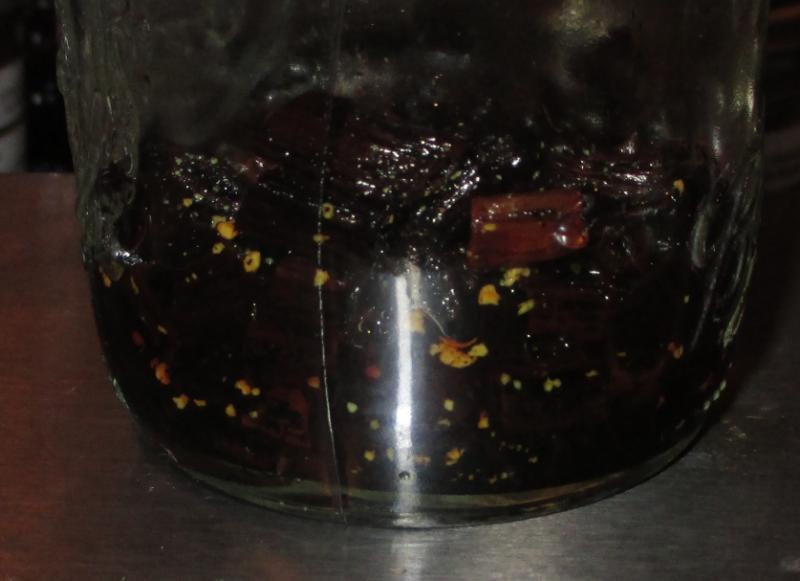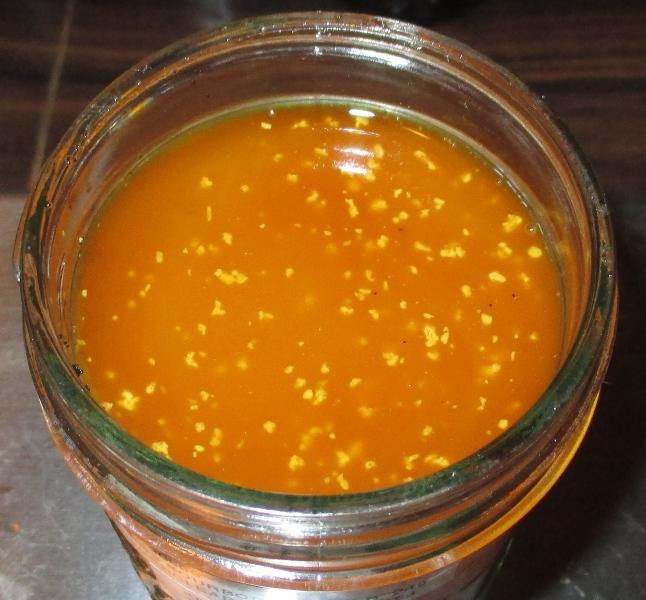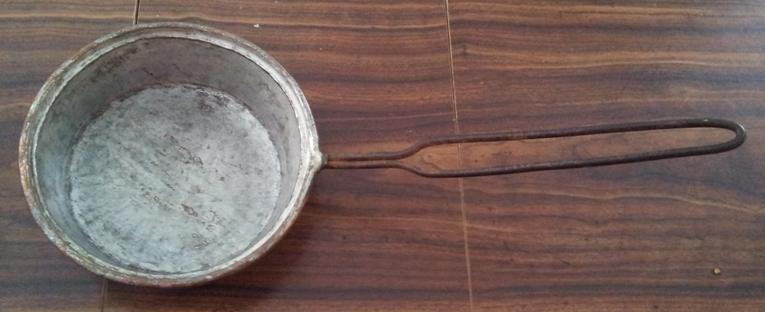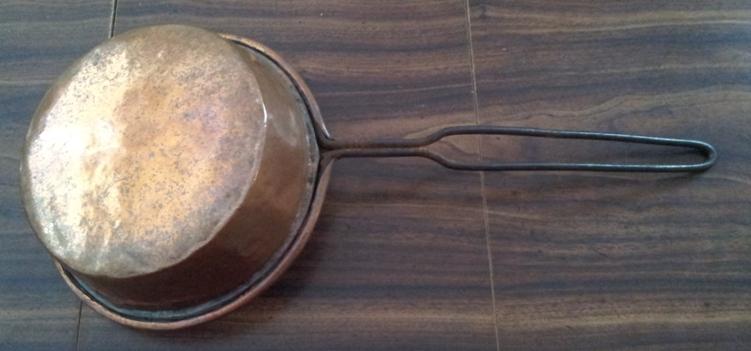
thock
participating member-
Posts
314 -
Joined
-
Last visited
Content Type
Profiles
Forums
Store
Help Articles
Everything posted by thock
-
No, no spelt or rye, and as I said, he's not complaining, so I'm not going to change it, at this point. Yeah, I was expecting dense, too. I've been pleasantly surprised not only by the taste and texture, but also by the simplicity. I work from home, but frequently have meetings either in or out of the office, so it is important to me that I not need to have to handle the dough on a regular basis. My method started out as an experiment, and it has worked out well. I have been eating a lot of sourdough pancakes, lately, too, which are tasty. Since S.O. doesn't eat them a lot, I just use 100g of starter, 1 large egg, about 5 g oil, and a couple grams each of salt and baking soda. That makes about half a dozen pancakes, and I am not "wasting" starter. I store it in the fridge until I'm ready to make pancakes. I am going to try to make banana bread using starter, too, just to use some of it up. But first, I need to liberate my KitchenAid from storage.
-
Happy birthday, Andie! Beautiful pitcher.
-
I started back bread-making in early February. I used to use a bread maker, but it was inconvenient to bring it to the kitchen, so I haven't been using it, this time around. I started out with a few yeast experiments, basically prompted by the discovery of a dried-out, yet not moldy, cake of fresh yeast in the fridge. I had bought it a year ago, this past holiday season, and had promptly forgotten about it. I was curious to see whether it could be "revived," so I mixed it with a little water and sugar. To my amazement, it bubbled, so I used it to make a loaf of bread. I forgot to add salt to the dough, so it was kind of flat-tasting, but it did work. It had a nice, moist, fine crumb. I saved a piece of the dough to try to use later as pate fermentee. I also started some instant yeast in a flour and water mix, just because I had heard that starting with a little yeast creates more flavor than a lot of yeast. Those experiments worked out well, too. I kept hunks of dough from those, too, and they're all in the freezer, at this time. I started a sourdough culture shortly after starting the yeast experiments, and when it was going well, I abandoned the commercial-yeast breads for 100% sourdough breads. When it was just about ready, but not quite, I started making pan breads with my starter. I didn't follow any recipe, as such, but just added water to the starter, and flour to the water, until I got something that looked and felt ok. I kept track of the weights, and increased each of them over time, until I was filling the pan well. After getting a white loaf that went over well, I decided to add white whole wheat to the mixture. Whole wheat because I wanted to add fiber to the bread, and white whole wheat because it's less hassle to get certain people to eat things with whole wheat if it's not as obvious. I've been getting compliments from the other half about the breads, which is good, because he's difficult to please. Where I like crusty loaves, he likes thin, soft crusts. He also has an aversion to whole grains. He says they're "acidic-tasting" to him, so it's a victory when a 50% white whole wheat loaf is pronounced "the best, yet." The other day, I needed to make some bread, but didn't have time for a sourdough dough cycle, so I used my starter, but added a teaspoon and a half of instant yeast, to make it rise faster. That went over best of all, because it wasn't as sour. I was told that he didn't really like the sourdough taste as much. I think that part of the reason it wasn't so sour was that I used double the amount of starter that I normally do, adjusting the water and flour to account for the added volume. I am currently trying the exact same formula, without the addition of yeast, to see how that is received. I have been getting consistently close, fine grain structure, which is good, because we like to use this for sandwiches. The doughs are 70% hydration, if I'm figuring it right (total water divided by total flour), so they start out really sticky, but end up being less so in the end. I'm not doing a lot of kneading, either. I mix the starter and water, add the flour and salt, mix it with a spoon until it's mostly together, then use my hand to finish mixing. Then, I let it rest for a while (half an hour to several hours), and then deflate, if necessary, and pick up the dough ball and turn it under in my hands a few times, put it back in the bowl to rise, then deflate, shape, pan and rise before slashing and baking. I think I gleaned all this from people's comments about artisan bread and things like that, and it's worked out well. No pictures, but I'm enjoying this.
-
I recently used walnut oil on a large Lodge Logic skillet. I did not completely remove the old seasoning, just scraped and scraped with a putty knife that I keep for such things, then washed, dried on the stove, and then poured a little walnut oil in and wiped with a piece of white t-shirt rag. I heated it on the stove, then wiped it with the rag again, just so you could barely see that the pan was "moistened." I repeated this several times, then finished up with a wipe and a cook in a 550F oven, twice. It's got a very nice, even coating on it, now, that I have never gotten on this particular pan, because I never bothered to season it beyond what it came with. I've seasoned LOTS of cast iron, and so far, this is my favorite method. And I used walnut oil I'd gotten at Big Lots for about $2.00. I would say, however, that while I used walnut oil, this method of barely "moistening" the pan is probably at least as much the reason for the good seasoning as is the oil that I chose to use.
-
Andie, I was curious what the difference might be between first extraction using high-proof vs. "normal-proof" alcohol. Some had said they didn't like the overproof stuff as much, but I wonder if they were using overproof for the whole volume of alcohol. That's why I started my experiment. I wanted to see for myself what the differences might be. I can tell you, it's been a learning experience. Have you ever seen little yellow globs in your initial Everclear extractions, before you added the rest of the alcohol? I think that I will probably do single-fold extractions for gift giving, but from here on out, I think I will make double- or quadruple-strength extractions from which to make vanilla syrup. Single-fold (or less, really) has too much of an alcoholic taste to it when combined with the syrup. My partner LOVES vanilla syrup. He got hooked on it when I found a bunch of Starbucks vanilla syrup at a deep discount at a local salvage store.
-
Yes, four times the amount of beans. Apparently, "X-fold" is a typical vanilla industry term. I only saw the first link. I totally missed the second one. But in any case, I wasn't really talking about strength, but characteristics. Sweet almonds are a lot different from bitter almonds, so I don't know in what way the extracts will differ. I'm looking forward to seeing what your experiences are. In terms of quantity to use, I can only imagine that the more you use, the stronger the extraction will be.
-
It should be fine to omit the Everclear and use just the 80-proof stuff. Christmas should be fine, too. As far as weight of beans per 8 ounces of alcohol (or of total volume, really), the more beans you add, the stronger your vanilla will be. There was a guy who stuffed a one-liter bottle full of all his vanilla beans (or maybe it was a gal, I don't know) and left it. It apparently turned out VERY strong. I am experimenting with this idea, and have a four-fold extraction going that has beans filling up the jelly jar, with alcohol taking up the rest of the room. It smells heavenly. Obviously, this would be used in smaller amounts in recipes, or to give a HUGE vanilla kick. It's really up to you how strong you want to go, but I would recommend, based on my experimentation and experiences, and the FDA definition of vanilla extract, that you don't want to go weaker than that, so that you aren't disappointed by your extraction. With the almond extract, I think you might be well served to make two different extractions of different strengths, and see what you like the best. I read that site's instructions, and I'm not convinced it would make an almond extract that would be similar enough to store-bought for my tastes. However, it did remind me that an "almond" extract can be made by macerating peach pits, so I might try that at some point. Have fun! :-)
-
Here is a website I found on making extracts so while I'm making the vanilla I also plan to make the almond as it looks super easy. http://www.commonsensehome.com/how-to-make-homemade-extracts/ Oh, I love almond extract. I'll have to check that out.
-
If you've got a scale, weigh the beans. I used 24 grams of beans for an 8-oz. jar of alcohol. I really don't remember how many beans that came to, but if you weigh them, you'll be ok. That will give you a single-fold extraction. You can always up the bean count, if you feel like it. Andie starts her extracts with high-proof Everclear, but I don't think she can get the 190-proof, like I can in Kansas. I think she's limited to the 151-proof. That should be good enough, though. You just add enough of the high-proof stuff to cover the beans, then in a month, cover with 80-proof alcohol. That jumpstarts the extraction, but then also gives you lower-proof alcohol to finish it with. I think it might be the best of both worlds to combine the two. However, if you want to keep it simple, you might just get the 100-proof stuff and be done with it. That said, I won't know for sure for a few months. I don't really drink vodka, much, myself, but I have used both cheap stuff and not-so-cheap stuff. I tend to buy local, if I can, which means I've used cheap McCormick, and not-so-cheap 360, and really, I couldn't tell much of a difference, but I also let my extracts sit for a good, long time to mellow. And I think bean quantity is going to make more of a difference than quality of vodka. But, not being a vodka aficionado, I could be completely barking up the wrong tree on the vodka-quality issue. I just was going back through this thread, a few pages, and noted that my Bourbon splits were called "near-gourmet," which I think means that they would have been gourmet if they hadn't had splits in them. I did notice a definite difference in the appearance of the unfinished "A" and B extracts, in that the B extracts had a lot of oils pulled out of the beans that the A extracts did not. I really don't think you're going to see a huge difference in the end product, but I won't know, on my end, for a few months, yet. Good luck, and keep us posted on what you end up doing. Whatever you do, I'm sure you will be satisfied with your extract, as long as you have enough beans in the alcohol.
-
I know this was posted a long time ago, but, cmo, I would like to let you know that ALL of the extracts I started in the post above yours, and the ones I started in 2012, were vacuumed a bit. I think this is an effect of temperature change and sealed alcohol, but I don't know for sure. There may be some ethanol evaporation over time, too, but I really don't know if oxygen and ethanol molecules are similarly sized. I do know, though, that these jars were closed in June, when it was in excess of 80 degrees in the house, and I opened them in February, when it was in the high 60's to low 70's, so some gas contraction could have an effect. This is all just to say that I don't think that what happened to your extracts was unusual, and they're probably safe to use. Just found this, which talks about the latent heat of vaporization. Haven't read through the whole thing, yet, but it sounds like it might explain the phenomenon. ETA link.
-
You can probably use the Grade B beans for things other than extract. The ones I've gotten have not been ugly, and the Bourbon variety, at least, are plenty oily/moist.
-
Ok, then! Andie to the rescue, again! Thanks, Andie!
-
Well, I looked up Copco, the brand of kettle this is, and called them. They said the copper-bottom kettle is bare copper on the inside. I'm not going to worry about it, at this point, although I will keep my eyes peeled for more info on copper and water. Thanks for your responses, everyone!
-
Ooh, that sounds good! I think they still have a bit of flavor left to them, even after alcohol extraction, and it seems such a shame to waste vanilla flavor/smell. I would love to get a poppy seed grinder, or something similar. I'm guessing a Sumeet is an electric wet spice grinder?
-
I did pick one out of one of the jars and squished it. It smooshed rather easily, lending credence to the idea that it was fat, and not vanillin. Interestingly, after a couple of hours, the extractions started with vodka were noticeably darker than the ones started with Everclear. Very noticeably. The Everclear ones were still cloudy, and the little yellow nodules were still intermixed with the beans and/or floating on the tops of the alcohols. Also, I misspoke (-typed?) when I said that the 2012 extractions are in current use. I checked again, and they are the 2010 extractions to which I added new beans around the same time I started my experiment. It's worth noting that even at less than 100% FDA-approved concentrations, these extracts make for good flavoring of yogurt and simple syrup. Last night, I dug the 2012 extractions out of the back of the cabinet and had my honey open them (because my hands are too small, and they'd formed a partial vacuum). They smelled wonderful, and are very dark. I'm going to keep them in the cabinet until we've used up the last of the 2010 extractions. I have no idea when that will be, but I will let you know when I dig them out. Also, the 4-fold extraction is noticeably more "vanilla-y" than the single-fold extractions. I expected this. It's also significantly darker. I think I'm just going to keep topping it up with vodka as the alcohol evaporates. I shoved half the Everclear/vodka extractions to the back of the cabinet with the 2012 extractions to await opening at an uncertain future time. The rest, along with the pure vodka extractions, will follow the original experimental plan as closely as I can manage. I will check on them next in June (if I remember-probably ought to set a reminder) and then not again until June 2015. At that point, I will decant/strain half of the Everclear/vodka and all of the all-vodka concoctions and run a blind taste test with at least me and my S.O. If I can manage it, I'll drag others into it, as well. I will also use some Kirkland vanilla extract and some Nielsen Massey (I think) extract and see if one wins out over the others. I will attempt to repeat this periodically, adding the over-2-years, the continuous-replenishment, and the 4-fold extracts to the mix. Just out of curiosity, I'll probably try a secondary extraction on at least some of the bean bits, just to see what happens, after I've strained. The rest I'll just dry and put into a jar of sugar.
-
I have a tea kettle that I inherited from some friends who moved out of town several years ago. I boiled it dry, once, and it got this black coating on the bottom of the copper bottom. I scrubbed it off, and scrubbed the inside, and promptly put it back in use. It's fairly thin-bottomed, so I figured the copper was a wash. I haven't used it in quite a while, and had standing water in it for a while. I dumped the water out, yesterday, and noticed some greenish discoloration on the INSIDE of the kettle. "Oh, crap," I think. I put some vinegar and water in the kettle to cover by about half an inch and warmed it on low on the range. Lo and behold, shiny-(ish) copper on the inside. I have NO idea whether there was tin inside, before, or not. Obviously, there's not now. Is it dangerous to boil water for human consumption in this thing? The body of the kettle is stainless, I think.
-
I must hang my head in shame. I got busy after I made that post, and only just today topped up the extractions with the larger amount of alcohol. AND, I forgot about the rum part. However, I can tell you that I have some preliminary results. All of the 2013 Bourbon bean extractions started in Everclear had what appeared to be vanillin crystals mixed in with the beans. None of the 2009 Bourbon, or any of the Tahitian extractions had this. All the extractions started in Everclear clouded up immediately upon addition of 150 g of 80- to 82-proof vodka. None of the extractions started in vodka did. This tells me that Andie's technique of starting with a high-proof alcohol works a lot better at extracting the vanillin than starting with a lower-proof alcohol. They all smelled heavenly, especially the four-fold extract. I topped that one off with 25 g of vodka, since it looked a little low. I will uncork these in June, except the 2-year extraction, and see how they are. Since I have doubles of the Everclear/vodka extractions with each bean type or combination, I may keep half of them around for a long time. My older extractions, started in 2012, are pretty good. We're using them in yogurt and in simple syrup for my partner. He uses the syrup in tea and coffee. I did have the crystals, or whatever they were, in the 2009 Bourbon beans, too. These only occurred in the Grade B Bourbon beans, and not in the Bourbon splits or the Tahitian beans. The crystals were yellowish, or cream-colored. Here are some pictures. Now that I think about it, they might be oils extracted by the alcohol. I'll have to pick one out and squish it to see what it feels like.
-
I must hang my head in shame. I got busy after I made that post, and only just today topped up the extractions with the larger amount of alcohol. AND, I forgot about the rum part. However, I can tell you that I have some preliminary results. All of the 2013 Bourbon bean extractions started in Everclear had what appeared to be vanillin crystals mixed in with the beans. None of the 2009 Bourbon, or any of the Tahitian extractions had this. All the extractions started in Everclear clouded up immediately upon addition of 150 g of 80- to 82-proof vodka. None of the extractions started in vodka did. This tells me that Andie's technique of starting with a high-proof alcohol works a lot better at extracting the vanillin than starting with a lower-proof alcohol. They all smelled heavenly, especially the four-fold extract. I topped that one off with 25 g of vodka, since it looked a little low. I will uncork these in June, except the 2-year extraction, and see how they are. Since I have doubles of the Everclear/vodka extractions with each bean type or combination, I may keep half of them around for a long time. My older extractions, started in 2012, are pretty good. We're using them in yogurt and in simple syrup for my partner. He uses the syrup in tea and coffee.
-
Very cool. Thanks, Andie! You always have good information. I don't have a wood stove, but I think I will use this particular piece as decoration.
-
I found this a while back. I think it was at a thrift store, but I'm not really sure. There are no markings, that I can discern. It appears that the wire handle is steel, and that the pan itself is tinned copper and about 6" in diameter. I think that the tin is worn off in spots. The bottom of the pan is not flat in the slightest, and looks like it's seen its fair share of heavy use or abuse. Any ideas about what this might have been used for, once upon a time?
-
While I agree with you on the raisins in lasagna (who came up with THAT?!?), I LOVE oatmeal raisin cookies, so I can't agree with you about only "in the hands of the young."
-
There's nothing wrong with that. Mine did that, too. I've used it and haven't gotten ill. It has also done this with other infusions. I imagine it has something to do with the ambient temperature at the time of year when you package it, and the cooling/heating cycle of ambient temps.
-
Ok, I have designed and set up my experiment. I have a whopping 21 half-pint jars of incipient vanilla extract, all but one of which are single-fold. The other is a 4-fold. I took the FDA definition of 13.35 oz of vanilla beans per gallon of extract and figured I'd need about 24 grams of beans per jelly jar. I have 6 different beans or combinations of beans: Bourbon, Grade B from 2013; Bourbon, Grade B from 2009; Tahitian, Grade B from 2013; Tahitian, Grade B from 2009, Bourbon, splits (near-gourmet, according to Vanilla Products) from 2013; and a combination of 50% Bourbon, 50% Tahitian, Grade B from 2013. I have three different alcohol extractions: Everclear 190-proof followed by vodka, 80-proof, Everclear 190-proof followed by rum, proof yet to be determined (I have a month, and I just don't have the bottle in front of me, but the rum is picked out), and 80-proof vodka followed by 80-proof vodka. I am using two different vodkas, UV and 360, because that's what I had. I believe all but one of the extracts will have UV vodka in it, as the "starter" vodka, if it starts with vodka rather than Everclear. They will all be topped up by 360 vodka. The idea behind starting some with Everclear and some with vodka is to maintain the "starter" aspect of the infusion, while varying the type/strength of the alcohol, to keep variables to a minimum. This is the matrix of experiments: Bean (24 g) Alcohol to start (25 g) Alcohol to finish (weight TBD) Bourbon, B, 2013 Everclear Vodka This will be strained after 2 years and kept to compare with other samples. Bourbon, B, 2013 Everclear Rum Bourbon, B, 2013 Vodka Vodka Bourbon, B, 2009 Everclear Vodka Bourbon, B, 2009 Everclear Rum Bourbon, B, 2009 Vodka Vodka Tahitian, B, 2013 Everclear Vodka Tahitian, B, 2013 Everclear Rum Tahitian, B, 2013 Vodka Vodka Tahitian, B, 2009 Everclear Vodka Tahitian, B, 2009 Everclear Rum Tahitian, B, 2009 Vodka Vodka Bourbon/Tahitian, B, 2013 Everclear Vodka Bourbon/Tahitian, B, 2013 Everclear Rum Bourbon/Tahitian, B, 2013 Vodka Vodka Bourbon, splits, 2013 Everclear Vodka Bourbon, splits, 2013 Everclear Rum Bourbon, splits, 2013 Vodka Vodka Bourbon, B, 2013 Everclear Vodka This is to test with continuous replenishment, i.e., use a tablespoon, add a tablespoon of vodka Bourbon, B, 2013 Everclear Vodka This is to keep unstrained for over 2 years to test whether the flavor/strength improves beyond that time. Will be compared with a strained sample of a similar experimental sample. Bourbon, B/splits, 2009/2013 Everclear (45 g) Vodka (45 g) This is a four-fold concentration with 32 g each of Bourbon Grade B from 2009 and 2013 and Bourbon splits from 2013. So, this will be a long-term experiment. All in the name of Science! (not really) Also, in doing the calculations for the strengths, I estimated the weights of the beans used for my previous extracts, from the calculated average bean weight and number of beans used. Sadly, I was between 18-20% concentration, which is about a 1/5-fold extract, for the ones started in 2009 and 2010. However, for the extraction I started in November 2012, I'm around a 250%, or 2.5-fold extract, as I had previously calculated. I looked at the 2012 extracts, today, and compared to the 2010 and to commercial extracts (Kirkland), the 2012 extracts are MUCH darker than their 2010 counterparts, and more on a par with the commercial variety. Before I did the calculations, I added between 24 and 28 g of beans to the 2010 extractions to up the concentration. There was about a pint of the Bourbon bean extract left and a bit over a pint of the Tahitian bean extract left. Accounting for the original concentrations of 20% and 18%, I will end up with a 71% and a 77% extraction on these, eventually. I will leave the beans in these, and not bother with documenting their effectiveness from here on out, but will just use them. It's worth noting, too, that the 2009 beans, both Tahitian and Bourbon, were noticeably more pliable and oily than their 2013 counterparts. I don't know why this may be, but I could definitely tell the difference when cutting them with kitchen shears. For the record, I snipped all the beans into about 1/8" to 1/4" bits. I was not very careful to make sure the pieces were all the same size. I figured that over the duration of this experiment, it didn't really matter. Already, this has been an educational experience.
-
I was looking for my vanilla extract notes, and came upon my receipt from my bean purchase in 2009. Tahitian beans were $10.98 a pound and Madagascar beans $16.47 a pound in November 2009. As I recall, between now and then, there was a massive crop failure, which boosted prices.


